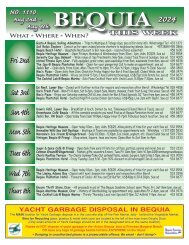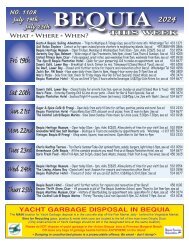Caribbean Compass Yachting Magazine - April 2021
Welcome to Caribbean Compass, the most widely-read boating publication in the Caribbean! THE MOST NEWS YOU CAN USE - feature articles on cruising destinations, regattas, environment, events...
Welcome to Caribbean Compass, the most widely-read boating publication in the Caribbean! THE MOST NEWS YOU CAN USE - feature articles on cruising destinations, regattas, environment, events...
Create successful ePaper yourself
Turn your PDF publications into a flip-book with our unique Google optimized e-Paper software.
THE BOATS OF SARTENEJA<br />
by Edward Le Rouvre<br />
he Sarteneja Easter Regatta is a very popular<br />
T event in the north of Belize, gathering the fleet of<br />
traditional wooden fishing boats and bringing hundreds<br />
of visitors from the surrounding inland and coastal<br />
communities of the Corozal and Orange Walk Districts.<br />
Artisanal fishing is an important activity in the country,<br />
mainly with the lobster and conch exportation to the<br />
USA, supported by a network of national cooperatives<br />
(first established in 1953) and extensively regulated by<br />
different zone management entities and the Fisheries<br />
Department (the first Fishery Act dates back to 1948).<br />
This artisanal fishing in traditional gunter-rigged<br />
wooden boats from Sarteneja, Chunox and Copper<br />
Bank villages of northern Belize is unique in Belize<br />
and the region. The Sarteneja Fishermen Association<br />
has membership of 140 fishermen. Sarteneja is the<br />
most important fishing community of Belize and is the<br />
only remaining boatbuilding village, with four<br />
shipwrights still active.<br />
Ten months a year the traditional fishing sloops are<br />
mostly stationed in the iconic Haulover Creek in Belize<br />
City (next to the historic swing bridge on the Belize<br />
River). From there, each small sailing vessel with<br />
dugout canoes piled on deck, the icebox loaded with<br />
ice supplied by the cooperatives, and its ten fishermen<br />
(more or less, plus one cook and a stove) goes to its<br />
working zone for a fishing campaign of eight to ten<br />
days. They anchor all along the Barrier Reef and the<br />
three outside atolls, and the men free dive with only<br />
their mask, fins and hook, keeping their catch in their<br />
canoes before storing it in the vessel’s icebox.<br />
When the lobster season closes (formerly on<br />
February 15th; the closed season was changed to<br />
March 1st to June 30th this year) the fishing boats<br />
head back to where they were born and it’s time for<br />
the traditional haulout on the waterfront for the<br />
yearly maintenance job.<br />
Top: The starting line of the<br />
class with 24-foot keels.<br />
Above: Boats at the pier,<br />
Easter 2019<br />
Right: Master Shipwright<br />
Juan Guerrero of Sarteneja<br />
building Zayann.<br />
EDWARD LE ROUVRE (3)<br />
The village is boiling with activity, the waterfront<br />
packed with wooden boats hauled out one next to the<br />
other, masts tangling. One freshly painted sloop is<br />
launched, pushed by the men, and another one takes<br />
its place with the same rollers and crowed pulling on<br />
the rope. “¡Hallamos!”<br />
Shipwrights are in high demand; rot has no mercy<br />
and shipworms are not a legend. Two planks here, a<br />
few ribs over there, and this one goes for a new<br />
esperjo (transom) and will need a new zapata (keel<br />
shoe). All this teeming activity is cadenced by the<br />
hammer hitting the caulking iron on decks for new<br />
estopa (caulking).<br />
The date of Easter affects the number of participants,<br />
and definitely the number of freshly painted boats on<br />
the pier ready to race. Who is going to finish in time?<br />
The days before the new shiny sets of sails float on the<br />
horizon, teams of crews are practicing. The public pier<br />
of Sarteneja is now the most active of Belize. Pickup<br />
trucks are bringing the sandbags for moveable ballast,<br />
and the special rigging and sails with long bamboo<br />
booms, the botabajas, that are significantly longer<br />
than the working spars, the booms reaching far<br />
behind the stern. For the most serious about the race,<br />
a set of Dacron sails replaces the cheaper polyester.<br />
The first date of a regatta here appears to be 1956,<br />
when Sarteneja was a farmer’s community with a fleet<br />
of cargo boats delivering produce to San Pedro<br />
(Ambergris Caye) and Belize City. A testimony of that<br />
time is the nickname for the Sartenejeños: los<br />
Tomateros. The shallow waters of the Chetumal Bay<br />
(on the border between Belize and Mexico) were also a<br />
major navigational and commercial hub for the<br />
Mayas, and then later for the wood loggers of early<br />
British Honduras and even for smugglers going to and<br />
from Mexico.<br />
Alexandro Gongora, or “Tiger,’’ like most Sartenejeños,<br />
was a fisherman most of his life. He was also<br />
administrator of the local former cooperative (closed in<br />
1982). Now he is the postman of the village (and<br />
therefore he collects my monthly paper, Le Monde<br />
diplomatique, while I’m away on my boat for the season).<br />
Alexandro knows many stories of the village, also<br />
because he was seriously engaged in politics with the<br />
People’s United Party (PUP), one of two major political<br />
parties in Belize. He tells me, “Sarteneja Village’s tradition<br />
before venturing into the fishing industry was agriculture.<br />
—Continued on next page<br />
APRIL <strong>2021</strong> CARIBBEAN COMPASS PAGE 19

















